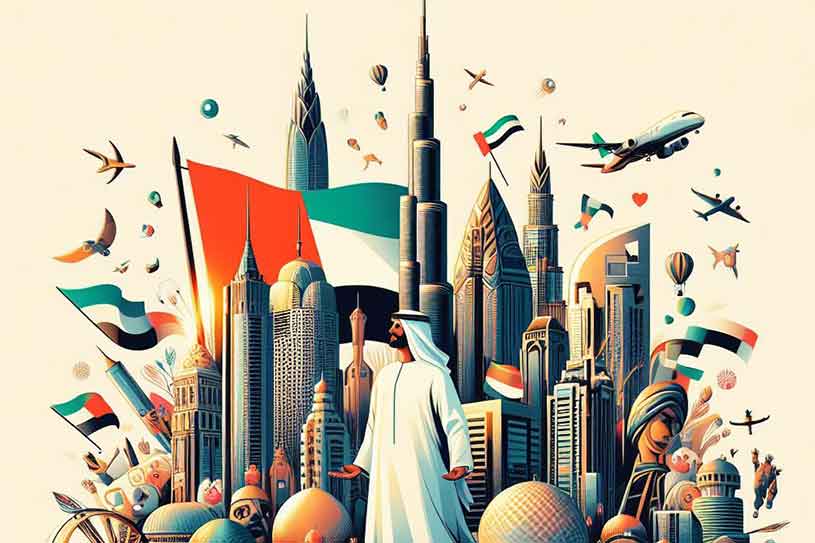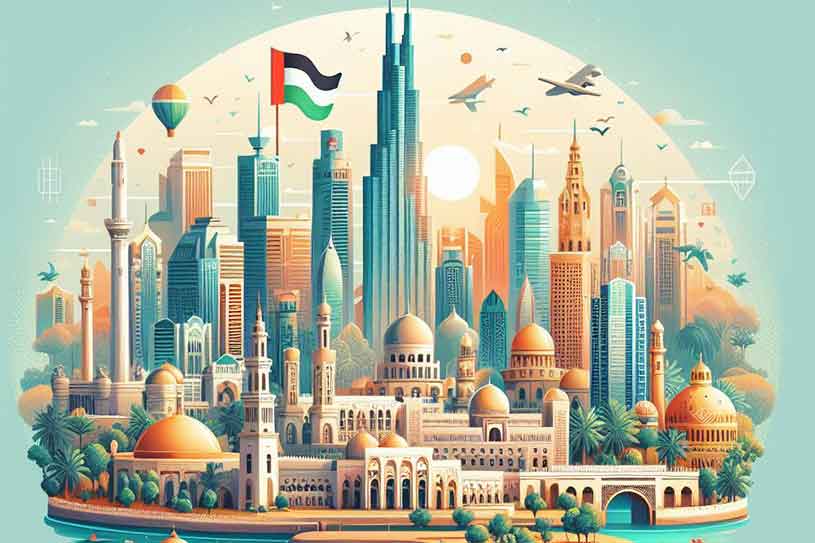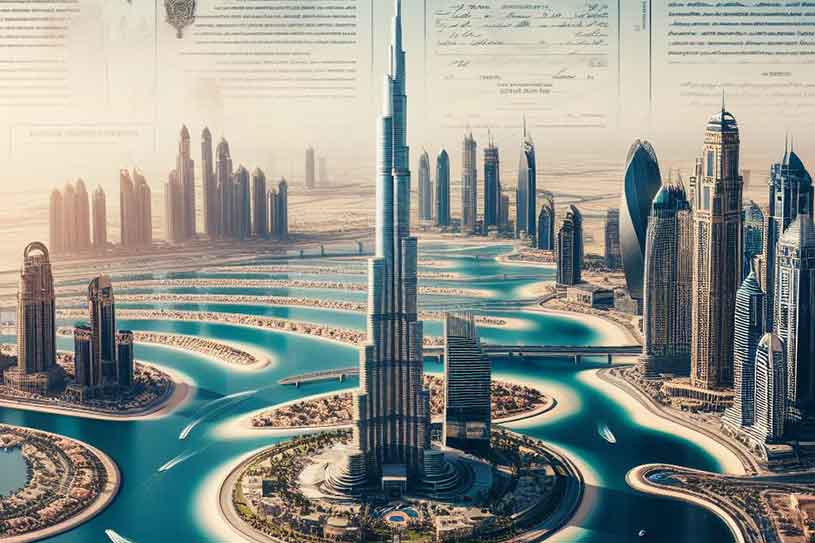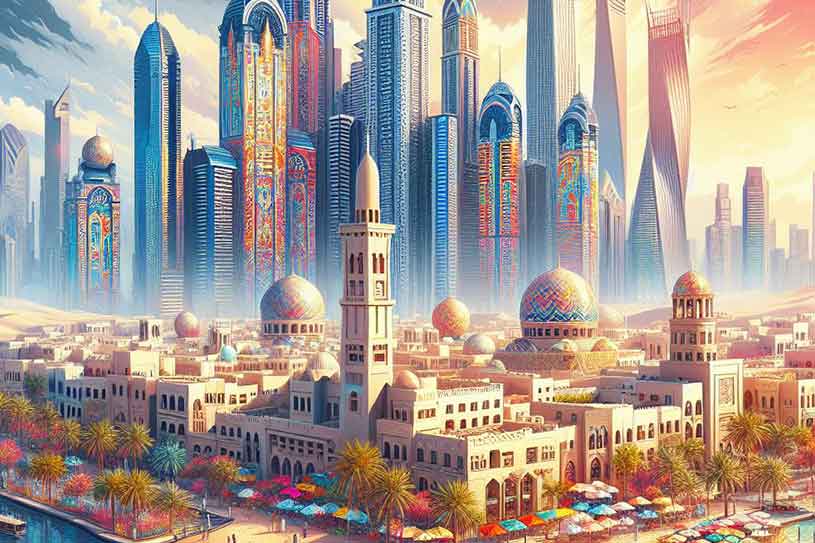The United Arab Emirates, commonly referred to as the UAE, is a rising star among the countries of the Arab world. Located in the eastern part of the Arabian Peninsula along the glimmering Persian Gulf, the UAE has transformed over the past five decades from a sparsely populated region of desert tribes into a modern, cosmopolitan country brimming with multicultural diversity.
Encompassing a total land area of over 80,000 square kilometers, the UAE might seem small on a map, but it casts an outsized influence as a regional leader in tourism, trade, technology, tolerance and innovation. The nation’s two largest emirates, Abu Dhabi and Dubai, have emerged as rising centers of business, finance, culture and architecture, boasting instantly recognizable skylines punctuated by cutting-edge towers and iconic structures.
Beyond the glittering cityscape, the UAE offers a blend of experiences and attractions ranging from the timeless to the hyper-modern – from serene desert landscapes dotted with oases and roaming camels, to Formula One racing circuits, artificial luxury islands and indoor ski slopes.
As a relatively young country celebrating only its 50th National Day in 2021, the UAE has covered remarkable ground across the economic, governmental and societal spheres. The nation has leveraged its oil wealth and strategic coastal location to vault into the top ranks globally in terms of economic competitiveness, quality of life, and openness for business and tourism.

Let’s explore some key facts and components behind the UAE’s dramatic ascent, looking at everything from geography and governance to trade prospects and tourism potential.
The Lay of the Land in the UAE
Geographically, the UAE occupies a coastal strip at the southeastern corner of the Arabian Peninsula, protruding into the Persian Gulf, Gulf of Oman and Strait of Hormuz. The country shares land borders with Saudi Arabia and Oman, and maritime borders with Iran and Qatar. Internally, the UAE comprises seven hereditary absolute monarchies known as emirates:
The emirates exhibit diversity across their landscapes, with some featuring sandy deserts or jagged mountains while others host muddy wetlands and golden beaches. Most of the country falls into an arid desert climate classification, with extremely hot and humid summers giving way to mild, pleasant winters. The lush Al Ain oasis and mountain enclaves like Jebel Jais offer exceptions featuring somewhat cooler and wetter microclimates.
Administratively and politically, governance duties are divided between federal bodies like the Supreme Council and individual emir-ruled monarchies heading each emirate. We’ll explore the governmental structure further in the next section.
Political Process in the Emirates Federation
Since the UAE’s formation in 1971 under founding father Sheikh Zayed bin Sultan Al Nahyan, the country has been governed as a federal constitutional monarchy. This means that while the emirates retain autonomy in many policy spheres, they also coordinate on overall strategy as members of the UAE federation.
The system is anchored by the Supreme Council, consisting of the seven hereditary emirate rulers plus an elected President and Vice President. Using Abu Dhabi emirate as an example, executive power resides with the Emir, Sheikh Khalifa bin Zayed Al Nahyan, as well as a Crown Prince, Deputy Rulers and Executive Council. This monarchical structure rooted in absolute rule repeats across all seven emirates.
The UAE’s Parliament-equivalent body is the Federal National Council (FNC), which can pass legislation and question ministers but acts in more of an advisory capacity rather than wielding concrete political clout. Its 40 members represent various emirates, tribal groups and social segments, offering a conduit for public feedback.
This centralized, top-down governance paradigm has delivered stability and efficient policymaking during the UAE’s rapid development push over the past half-century. However, human rights groups frequently criticize its authoritarian controls on free speech and other civic participation. Recently the UAE has taken gradual steps towards a more inclusive model, such as allowing FNC elections and expanding women’s rights.
Unity and Identity Among the Emirates
The seven emirates spanning the UAE’s territory vary widely in size, population and economic specialties, from tiny Umm Al Quwain to expansive Abu Dhabi. However, the federal unification initiated by Sheikh Zayed established bonds and interdependencies which hold firm today. Infrastructure links like the E11 highway connect all northern emirates, while shared institutions like the armed forces, Central Bank and state oil company bind the regions closer together.
Propagating a cohesive national identity and culture poses challenges with such a diverse, expat-heavy population. Unsurprisingly, policies emphasize symbols like the UAE flag, coat of arms and national anthem, as well as patriotic themes in school curriculums. Efforts to balance rapid modernization with Emirati cultural preservation can be seen across museum expansions, youth initiatives and tourism developments featuring falconry, camel racing and other heritage elements.
Ultimately the UAE’s multicultural fabric, relatively secular legal framework and religious tolerance help attract foreigners and investment essential to its globally integrated growth strategy. This cultural mélange also gives the country a unique cachet as a kind of modern intersection between East and West.
History as a Crossroads Hub in the Gulf
The UAE’s geographic location at the tip of the Arabian Peninsula has made it a hub for trade, migration and cultural interchange for thousands of years. Archaeological evidence indicates early human habitation and lively commercial links with Mesopotamian and Harappan cultures dating back to the Bronze Age. Over a millennium ago, the arrival of Islam catalyzed a political and social transformation across Arabia. Later, Portuguese, Dutch and British empires jousted for control over Gulf trading routes.
The region’s internal origins trace to 18th century alliances between various Bedouin tribal groups, which coalesced into today’s emirates by the 1930s. Britain also exerted heavy influence for much of the 20th century before granting independence in 1971 under visionary leader Sheikh Zayed, who quickly leveraged oil windfalls to spur development.
The UAE has deftly mobilized its strategic location and hydrocarbon resources to rise into a global top-tier economy and transport hub linking Europe, Asia and Africa. While energy exports and petro-dollars seeded growth initially, today the government actively fosters diverse industries like tourism, aviation, financial services and technology to carry momentum forward.
Economic Expansion Diversifying Beyond Black Gold
The UAE holds the planet’s seventh largest oil reserves, and this liquid bounty has gushed prosperity over the past half-century of commercial exploitation. Yet compared to neighbors like Saudi Arabia, the Emirates are exploiting new income streams in their quest to become the region’s foremost trade and business nexus.
International airports in Abu Dhabi and especially Dubai welcome new arrivals daily who contribute to the UAE’s economic output. Dubai alone logged 16.7 million visitors in 2019. Considering its miniscule native population, the UAE draws heavily on foreign workers with over 80% of residents being non-citizens. This migrant labor force literally builds the UAE’s commercial promise, evident in monumental infrastructure projects like the Burj Khalifa tower and artificial luxury Palm Islands.
The government helps attract people, trade and capital via liberal visa rules, advanced transport links, competitive tax incentives, and technological modernization like nationwide 5G and e-government portals. Oil and gas still supply 30% of GDP as of 2018, but new sectors like tourism now constitute 13%, education 3.25% and healthcare 2.75% revealing the push towards diversity.
Keeping apace with global dynamics, the UAE also sets regional standards on renewable energy adoption, sustainable mobility and support for advanced technology ecosystems. Multiple Emirati cities now host budding startup and entrepreneur scenes, leveraging youth demographics and rising tech savvy. With vast reserves still underground, monetary clout to fund development schemes, and strategic geography all as competitive advantages, forecasts remain bullish on UAE economic ascent boding well across corporate, civic and environmental dimensions.
Blending Tradition and Modernity in a High-Tech Oasis
Similar to borderless business zones flowingly merging across Emirates soil, the UAE offers a contradiction-rich decrepit landscape where seemingly opposed forces often intermingle more than clash. At once both conservative and audaciously ambitious, traditionalyet futuro-centric, the Emirati paradigm reconciles ostensible opposites by taking a progressive yet measured governance approach.
Officially the Constitution enshrines Sunni Islam and Sharia principles, alcohol is prohibited religiously yet easily obtainable for visitors, and authorities censor public dissent yet allow Western revelry in spaces like Dubai nightclubs. Meanwhile Abu Dhabi global financial authorities punish misconduct severely under Islamic codes, but allow flexibility for foreigners and civil normalization deals abroad transcending old taboos.
Rather than experiencing jarring culture shock in the UAE, outer displays of religious conservatism prove fairly skin-deep compared to neighboring countries. Rapid influxes of expat Arabs, Asians and Westerners have rendered Emirati culture far more pluralistic and tolerant than its regional repute suggests. Only needing to accommodate a small local population – 15% of total inhabitants – grants rulers breathing room when appeasing religious forces while crafting communal policies.
The UAE’s pioneering Smart City infrastructure and nationwide tech penetration likewise attest to this blending of heritage and futurology, where blade-shaped skyscrapers dwarf traditional dhow boats gliding across Dubai Creek’s waters. But rather than representing contradictory extremes on a modernization pathway, citizens view technological innovation as the means to catapult national development that unlocks equal opportunity.
Through deft resource allocation, economic openness and social integration policies, the UAE has cultivated a unique societal habitat where global talent and capital flows converge and concentrate.
Tourism Infrastructure and Draws Beckoning Global Visitors
Glitzy Dubai anchors tourism in the UAE, welcoming nearly 12 million annual visitors before the COVID-19 slowdown who inject billions in revenue while capturing endless vacation Instagram shares. This gateway emirate offers every attraction under the desert sun for travelers worldwide – luxurious resorts on picturesque beaches or artificial islands, world-class shopping and celebrity chef dining options, plus iconic architecture in the Burj Khalifa and upcoming Museum of the Future.
Pleasant winters make outdoor sightseeing feasible when avoiding the scorching summer months, and Dubai’s airline connects multiplied destinations directly. Nearby emirates also offer cultural and adventure travel alternatives, like trekking/camping escapes in Hatta or Fujairah’s east coast beaches.
Globally renowned events have also vaulted Dubai onto bucket destination lists, like the annual international air show, major golf championship, Dubai World Cup horse race, and world Expo hosting. Its vibrant multicultural fabric meshes mosques, churches and even temples given large Indian and Filipino populaces.
Abu Dhabi also holds intrigue for visitors with beach resorts and attractions like the jaw-dropping Sheikh Zayed Grand Mosque – a pearly and gilded architectural marvel. Yas Island’s Ferrari World and upcoming Warner Bros World indoor theme parks cater to families, while formulas racing aficionados can drive the Yas Marina Circuit themselves. Sir Bani Yas Island and desert nature reserves offer wildlife spotting escapes from urbanity.
Sharjah merits visiting for heritage museums and colorful Souk markets selling textiles, crafts and gold. Ajman and Ras Al Khaimah are developing coastal luxury tourism projects, while adrenaline adventures await amid Fujairah’s dramatic mountain scenery and year-round surfing waves.
In Summary…Key Things to Know About the UAE
- Strategic geography bridging Europe, Asia and Africa
- Federation of 7 emirates, largest being Abu Dhabi + Dubai
- Transformed from desert backwater to global hub within 50 years
- Blends skyscraper modernity with enduring cultural touchstones
- Economically diversified yet still Mideast’s second largest (by GDP)
- Socially liberal yet rooted in Islamic heritage and Bedouin tradition
- Ambitious vision driving advancement across sustainability, mobility and technology
- Tourism attractions span iconic architecture, markets, motorsports and more
Why Visit the United Arab Emirates?
More than just shopping escapades and business convenings, travelers visit the UAE to soak into its sensory overload of dizzying contrasts. Here ancient Islamic architecture butts against sci-fi esque hyper-towers, rollercoaster infrastructures like Palm Jumeirah dazzle while 1,000 year old trade sands swirl as before.
The UAE transmits enduring Arabian mystique clothed in 21st century innovation fabrics – a unique fusion that captivates human imaginations. Yearning for modern convenience need not forgo cultural immersion during UAE holidays. Visitors access ultra-efficient transport and services fitting a visionary Smart City while glimpsing camels loping along as in age-old caravans.
Such capacity to synthesize not just amplitudes the UAE’s magnetism, but virtualizes the realm’s geographic advantage that astute leaders like Sheikh Mohammed bin Rashid Al Maktoum now parallel online. Ambitious resilience plans equally battling sustainability crises will soon allow desert ecology exploration more easily.
As a dynamic Muslim state pioneering tolerance ahead whilst upholding faith values, the UAE proffers a replicable template that hopefully catalyzes progress across Middle Eastern development indices, economies and societies marred by conflict. From exoplanetary ambitions to AI governance, hereditary rulers exhibit visionary guidance securing stability required for further ascension.
So beyond luxury escapes or family fun, visiting the UAE grants exposure to humanity’s heritage/technology nexus with pathways ahead insightfully illuminated rather than obscured.
Faqs:
FAQs about the United Arab Emirates (UAE)
1. What are some basic facts about the UAE?
- Location, borders, geography, climate: The UAE is located in the Middle East on the eastern side of the Arabian Peninsula. It is bordered by Saudi Arabia to the south, Oman to the southeast, the Persian Gulf to the north, and the Gulf of Oman to the east. The country features a desert landscape with a hot and arid climate.
- Population and demographics: The UAE has a diverse population consisting of both Emirati citizens and expatriates. The population has grown rapidly due to immigration, making it a multicultural society.
2. Can you provide a brief overview of the UAE’s history?
- Early settlements and civilizations: The UAE has a rich history with evidence of early human settlements dating back thousands of years. It was home to ancient civilizations engaged in trade and fishing.
- Arrival of Islam: The region embraced Islam in the 7th century, greatly influencing its culture and society.
- European colonialism: European colonial powers, including the Portuguese and British, had a presence in the UAE during the colonial era.
- Formation of the UAE federation: The modern UAE was formed in 1971 when seven emirates united to create a single nation.
3. What are the seven emirates of the UAE, and what makes each of them unique?
- Abu Dhabi: Abu Dhabi is the capital and the largest emirate. It is known for its strong economy, particularly in the oil and gas industry, and iconic attractions like the Sheikh Zayed Grand Mosque.
- Dubai: Dubai is the largest city and commercial hub of the UAE. It is famous for its modern architecture, tourism, and thriving financial services sector.
- Sharjah: Sharjah is considered the cultural center of the UAE, boasting numerous museums, heritage sites, and a growing education sector.
- Other Northern Emirates (Ajman, Umm Al Quwain, Ras Al Khaimah, Fujairah): These emirates feature coastal towns, mountainous regions, and have experienced growth in real estate and tourism.
4. What is the political structure of the UAE?
- The UAE is an absolute monarchy with each emirate being governed by its own ruler. The rulers form the Supreme Council, which selects the President and Vice President of the UAE.
5. What is the legal system in the UAE?
- The UAE has a federal court system, and its legal system is based on a combination of civil law and sharia law, which applies mainly to personal and family matters.
6. What is the UAE’s foreign policy?
- The UAE maintains diplomatic relations with Arab states, Western powers, and Asian countries. It plays an active role in regional issues, including its stance on Iran and the Israel-Palestine conflict.
7. How has the UAE’s economy evolved, and what is its current economic status?
- The UAE’s economy has experienced rapid growth over the last five decades. It has diversified away from its dependency on oil and gas, focusing on various sectors such as tourism, trade, and finance.
8. What is the society and culture like in the UAE?
- The UAE has a multicultural population with a blend of expatriates and Emirati citizens. It has rapidly modernized while preserving its cultural traditions.
9. What is the dominant religion in the UAE, and how is religious tolerance practiced?
- Islam is the state religion in the UAE, but the country is known for its religious tolerance, allowing the practice of other minority faiths, including Christianity.
10. How does the UAE promote cultural development and heritage preservation?
- The UAE has been actively promoting cultural development through art scenes, festivals, and events. It also places a strong emphasis on preserving Emirati heritage and identity.
11. Why should one consider visiting the UAE?
- The UAE offers a unique blend of history and ultra-modern developments. It is an economic powerhouse while serving as a cultural crossroads. The country is known for its safety, stability, and tolerance, making it a modern Arab model.




